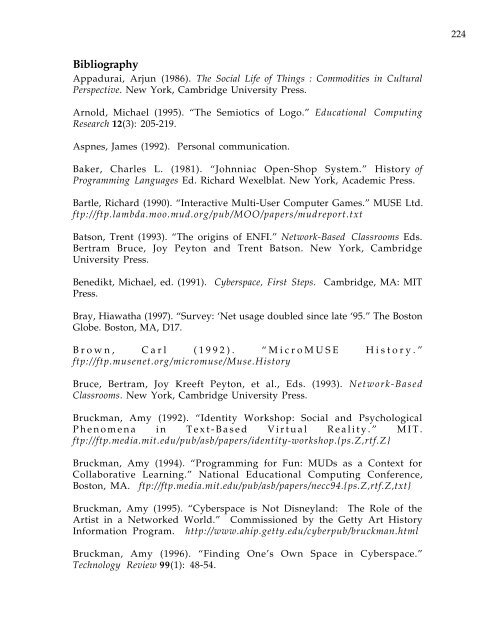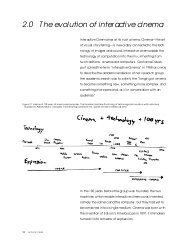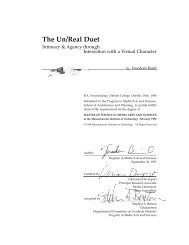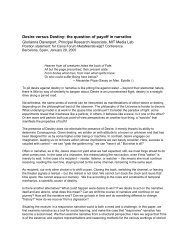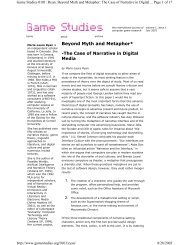Bibliography - Interactive Cinema Group - MIT
Bibliography - Interactive Cinema Group - MIT
Bibliography - Interactive Cinema Group - MIT
You also want an ePaper? Increase the reach of your titles
YUMPU automatically turns print PDFs into web optimized ePapers that Google loves.
224<strong>Bibliography</strong>Appadurai, Arjun (1986). The Social Life of Things : Commodities in CulturalPerspective. New York, Cambridge University Press.Arnold, Michael (1995). “The Semiotics of Logo.” Educational ComputingResearch 12(3): 205-219.Aspnes, James (1992). Personal communication.Baker, Charles L. (1981). “Johnniac Open-Shop System.” History ofProgramming Languages Ed. Richard Wexelblat. New York, Academic Press.Bartle, Richard (1990). “<strong>Interactive</strong> Multi-User Computer Games.” MUSE Ltd.ftp://ftp.lambda.moo.mud.org/pub/MOO/papers/mudreport.txtBatson, Trent (1993). “The origins of ENFI.” Network-Based Classrooms Eds.Bertram Bruce, Joy Peyton and Trent Batson. New York, CambridgeUniversity Press.Benedikt, Michael, ed. (1991). Cyberspace, First Steps. Cambridge, MA: <strong>MIT</strong>Press.Bray, Hiawatha (1997). “Survey: ‘Net usage doubled since late ‘95.” The BostonGlobe. Boston, MA, D17.Brown, Carl (1992). “MicroMUSE History.”ftp://ftp.musenet.org/micromuse/Muse.HistoryBruce, Bertram, Joy Kreeft Peyton, et al., Eds. (1993). Network-BasedClassrooms. New York, Cambridge University Press.Bruckman, Amy (1992). “Identity Workshop: Social and PsychologicalPhenomena in Text-Based Virtual Reality.” <strong>MIT</strong>.ftp://ftp.media.mit.edu/pub/asb/papers/identity-workshop.{ps.Z,rtf.Z}Bruckman, Amy (1994). “Programming for Fun: MUDs as a Context forCollaborative Learning.” National Educational Computing Conference,Boston, MA. ftp://ftp.media.mit.edu/pub/asb/papers/necc94.{ps.Z,rtf.Z,txt}Bruckman, Amy (1995). “Cyberspace is Not Disneyland: The Role of theArtist in a Networked World.” Commissioned by the Getty Art HistoryInformation Program. http://www.ahip.getty.edu/cyberpub/bruckman.htmlBruckman, Amy (1996). “Finding One’s Own Space in Cyberspace.”Technology Review 99(1): 48-54.
225http://web.mit.edu/afs/athena/org/t/techreview/www/articles/jan96/Bruckman.htmlBruckman, Amy and Mitchel Resnick (1995). “The MediaMOO Project:Constructionism and Professional Community.” Convergence 1(1).http://www.gold.ac.uk/difference/bruckman.htmlCherny, Lynn (1995). “The MUD Register: Conversational Modes of Actionin a Text-Based Virtual Reality.” PhD dissertation, Stanford University.Crowther, Will (1992). Personal communication.Curtis, Pavel (1993). “LambdaMOO Programmer’s Manual.”ftp://ftp.lambda.moo.mud.org/pub/MOO/ProgrammersManual.{ps,dvi,txt}Curtis, Pavel (1996). Personal communication.Dewey, John (1938). Experience and Education. New York, MacmillanPublishing Company.diSessa, Andrea A. and Harold Abelson (1986). “Boxer: A ReconstructibleComputational Medium.” Communications of the ACM 29(9): 859-868.Eisenberg, Michael (1995). “Programmable Applications: Interpreter MeetsInterface.” SIGCHI Bulletin 27(2): 68-83.Evard, Remy (1993). “Collaborative Networked Communication: MUDs asSystems Tools.” Seventh Systems Administration Conference (LISA VII),Monterey, CA, USENIX Association.http://www.mcs.anl.gov/people/evard/papers/cncmast.htmlFalbel, Aaron (1989). “Friskolen 70: An Ethnographically Informed InquiryInto the Social Context of Learning.” PhD dissertation, Massachusetts Instituteof Technology.Fanderclai, Tari (1996). “Like magic, only real.” Wired Women: Gender andNew Realities in Cyberspace Eds. Lynn Cherny and Elizabeth Weise. Seattle,WA, Seal Press.Feurzeig, Wally (1984). “The Logo Lineage” Digital Deli. Ed. Steve Ditlea.New York, NY, Workman Publishing Company.Feurzeig, Wally (1996). Personal communication.Frazier, Frank (1967). “The Logo System: Preliminary Manual.” Cambridge,MA, Bolt Beranek and Newman.
226Geertz, Clifford (1973). The Interpretation of Cultures. New York, Basic Books.Glusman, Gustavo, E. Mercer, et al. (1996). “Real-time Collaboration On theInternet: BioMOO, the Biologists’ Virtual Meeting Place.” Internet for theMolecular Biologist. Eds. S.R. Swindell, R.R. Miller and G.S.A. Myers.Norfolk, UK, Horizon Scientific Press.Goffman, Erving (1959). The Presentation of Self in Everyday Life. New York,Doubleday.Goodman, Danny (1988). The Complete HyperCard Handbook. New York,Bantam Books.Guzdial, Mark (1994). “Software-Realized Scaffolding to FacilitateProgramming for Science Learning.” <strong>Interactive</strong> Learning Environments 4(1):1-44.Harel, Idit (1991). Children Designers. Norwood, NJ, Ablex Publishing.Holdaway, Don (1979). The Foundations of Literacy. New York: AshtonScholastic.Honey, Margaret, Babette Moeller, Cornelia Brunner, Dorothy Bennett, PeggyClements, and Jan Hawkins (1991). “Girls and Design: Exploring the Questionof the Technological Imagination.” Technical Report No. 17. New York:Bank Street College of Education.Hooper, Paula (1997a). Personal communication.Hooper, Paula (1997b). “Their Own Thoughts.” <strong>MIT</strong>.Hughes, Billie (1996). Personal communication.Hughes, Billie and Jim Walters (1995). “Children, MUDs, and Learning.”AERA, San Francisco, CA.http://pcacad.pc.maricopa.edu/Pueblo/writings/bib/AERA-paper-1995.htmlHughes, Billie and Jim Walters (1997). Personal communication.Jenkins, Henry (1992). Textual Poachers, Television Fans and ParticipatoryCulture. New York, Routledge.Kaehler, Ted (1996). Personal communication.
227Kay, Alan (1996). “The Early History of Smalltalk.” History of ProgrammingLanguages-II . New York, ACM Press.Keller, Evelyn Fox (1985). Gender and Science. New Haven: Yale UniversityPress.Kleinschmidt, Klaus (1996). “The Internet is a waste of time for schools.” TheBoston Globe. Boston, 22.Klietz, Alan (1992). Personal communication.Kort, Barry (1997). Personal communication.Kurtz, Thomas (1981). “BASIC.” History of Programming Languages Ed.Richard Wexelblat. New York, Academic Press.Latour, Bruno and Steve Woolgar (1986). Laboratory Life: The SocialConstruction of Scientific Facts. Princeton, NJ, Princeton University Press.Laurel, Brenda, Ed. (1990). The Art of Human-Computer Interface Design.Reading, MA, Addison-Wesley.Laurel, Brenda (1991). Computers as Theatre. Reading, MA, Addison-Wesley.Lave, Jean and Etienne Wegner (1991). Situated Learning: LegitimatePeripheral Participation. Cambridge, UK, Cambridge University Press.Leron, Uri (1985). “Logo Today: Vision and Reality.” The ComputingTeacher.Levin, James A., Al Rogers, et al. (1989). “Observations on educationalelectronic networks: The Importance of appropriate activities for learning.”The Computing Teacher 16:Morningstar, Chip and F. Randall Farmer (1991). “The Lessons of Lucasfilm’sHabitat.” Cyberspace, First Steps. Michael Benedikt, editor. Cambridge, MA,<strong>MIT</strong> Press.Newman, Denis, Peg Griffin, et al. (1989). The Construction Zone:Working for Cognitive Change in School. Cambridge, England, CambridgeUniversity Press.O’Day, Vicki (1997). Personal communication.
228O’Day, Vicki, Daniel Bobrow, et al. (1996). “The Social-Technical DesignCircle.” CSCW 96, Cambridge, MA, ACM Press.Oldenburg, Ray (1989). The Great Good Place. New York: Paragon House.Papert, Seymour (1980). Mindstorms: Children, Computers, and PowerfulIdeas. New York, Basic Books.Papert, Seymour (1991). “Situating Constructionism.” Constructionism Eds.Idit Harel and Seymour Papert. Norwood, NJ, Ablex Publishing. 518.Pea, Roy (1993). “Practices of Distributed Intelligence and Designs forEducation.” Distributed Cognitions: Psychological and EducationalConsiderations Ed. Gavriel Salomon. Cambridge, England, CambridgeUniversity Press.Postman, Neil (1985). Amusing Ourselves to Death, Public Discourse in theAge of Show Business. New York, Viking.Putnam, Robert (1995). “Bowling Alone: America’s Declining Social Capital.”Journal of Democracy 6(1).Radway, Janice (1984). Reading the Romance: Women, Patriarchy, andPopular Literature. Chapel Hill, University of North Carolina Press.Raymond, Eric (1991). The New Hackers Dictionary. Cambridge, MA: <strong>MIT</strong>Press.Reid, Elizabeth (1991). "Electropolis: Communication and Community onInternet Relay Chat." Bachelors thesis, University of Melbourne.ftp://ftp.lambda.moo.mud.org/pub/MOO/papers/electropolis.{ps,txt}Resnick, Mitchel (1993). Personal communication.Resnick, Mitchel (1994). Turtles, Termites, and Traffic Jams: Explorations inMassively Parallel Microworlds. Cambridge, MA, <strong>MIT</strong> Press.Resnick, Mitchel, Amy Bruckman, and Fred Martin. “Pianos, Not Stereos:Creating Computational Construction Kits.” Interactions September/October1996, 40-50.Resnick, Mitchel (1997). “StarLogo Reference Manual.”http://www.media.mit.edu/~starlogo/documentation/refman.html
229Resnick, Mitchel, Robert Berg, et al. (1997). “Beyond Black Boxes: BriningTransparency and Aesthetics Back to Scientific Instruments.”Resnick, Mitchel and Natalie Rusk (1996). “The Computer Clubhouse:Preparing for Life in a Digital World.” IBM Systems Journal 35(3-4): 431-440.http://el.www.media.mit.edu/groups/el/Papers/mres/Comp_club/Clubhouse.htmlResnick, Paul and James Miller (1996). “PICS: Internet Access ControlsWithout Censorship.” Communications of the ACM Forthcoming.http://www.w3.org/pub/WWW/PICS/iacwcv2.htmRheingold, Howard (1993). The Virtual Community: Homesteading on theElectronic Frontier. Reading, MA, Addison-Wesley Publishing Company.Rogoff, Barbara (1994). “Developing Understanding of the Idea ofCommunities of Learners.” Mind, Culture, and Activity 1(4): 209-229.Rubin, Andee and Brad Goodman (1991). “TapeMeasure: Video as Data forStatistical Investigations.” Proceedings of American Educational ResearchAssociation, Chicago.Sammet, Jean (1981). “The Early History of COBOL.” History of ProgrammingLanguages Ed. Richard Wexelblat. New York, Academic Press.San Jose Mercury News (1996). “Clinton Makes Cyberspace Connection.” SanJose Mercury News. San Jose, CA, 18A.Scardamalia, Marlene and Carl Bereiter (1994). “Computer Support forKnowledge-Building Communities.” The Journal of the Learning Sciences3(3): 265-283.Schlager, Mark and Patricia Schank (1996a). “A Networked Environment forTeacher Professional Development.” SRI.http://tappedin.sri.com/info/concept.htmlSchlager, Mark and Patricia Schank (1996b). “TAPPED IN: A Multi-UserVirtual Environment for Teacher Professional Development and EducationReform.” The Virtual Classroom, Berkeley, CA,http://www.soe.berkeley.edu/~schank/TappedIn.htmlSchon, Donald A. (1987). Educating the Reflective Practitioner. San Francisco,Jossey-Bass.Shaffer, David Williamson (1996). “Escher’s World: Learning Mathematicsthrough Design in a Digital Studio.” <strong>MIT</strong>.
230Shaw, Alan (1994). “Social Constructionism and the Inner City: DesigningEnvironments for Social Development and Urban Renewal.” PhDdissertation, Massachusetts Institute of Technology.Skinner, B. F. (1968). The Technology of Teaching. New York, Appleton-Century-Crofts.Songer, Nancy (1996). “Exploring Learning Opportunities in CoordinatedNetwork-Enhanced Classrooms: A case of kids as global scientists.” TheJournal of the Learning Sciences 5(4): 297-327.Stone, Allucquere Rosanne (1991). “Will the Real Body Please Stand Up?:Boundary Stories about Virtual Cultures.” Cyberspace, First Steps. MichaelBenedikt, editor. Cambridge, MA, <strong>MIT</strong> Press.Strohecker, Carol (1991). “Why Knot?” PhD dissertation, MassachusettsInstitute of Technology.Turkle, Sherry (1984). The Second Self: Computers and the Human Spirit.New York, Simon and Schuster.Turkle, Sherry (1986). “Computational Reticence: Why Women Fear theIntimate Machine.” Technology and Women’s Voices Ed. Cheris Kramerae.New York, Pergamon Press.Turkle, Sherry and Seymour Papert (1992). "Epistemological Pluralism andthe Revaluation of the Concrete." Journal of Mathematical Behavior 11:3-33.Turkle, Sherry (1995). Life on the Screen: Identity in the Age of the Internet.New York, Simon & Schuster.Van Buren, David, Pavel Curtis, et al. (1994). “The AstroVR Collaboratory.”Astronomical Data Analysis Software and Systems IV Eds. R. Hanish and H.Payne. San Francisco, Astronomical Society of the Pacific.Vygotsky, Lev (1978). Mind in Society. Cambridge, MA, Harvard UniversityPress.Wall, Larry (1996). “Wherefore Art, Thou?” The Perl Journal 1(1): 5 - 7.Walters, Jim and Billie Hughes (1994). “Camp MariMUSE: LinkingElementary and College Students in Virtual Space.” National EducationalComputing Conference, Boston, MA,
231Weir, Sylvia (1992). “Electronic Communities of Learners: Fact or Fiction.”Cambridge, MA: TERC Communications.Winner, Langdon (1986). The Whale and the Reactor. Chicago: University ofChicago Press.Winograd, Terry and Fernando Flores (1987). Understanding Computers andCognition. Reading, MA, Addison-Wesley.


